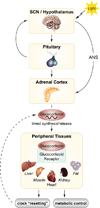Nutrient sensing and the circadian clock
- PMID: 22424658
- PMCID: PMC3389335
- DOI: 10.1016/j.tem.2012.02.003
Nutrient sensing and the circadian clock
Abstract
The circadian system synchronizes behavioral and physiologic processes with daily changes in the external light-dark cycle, optimizing energetic cycles with the rising and setting of the sun. Molecular clocks are organized hierarchically, with neural clocks orchestrating the daily switch between periods of feeding and fasting, and peripheral clocks generating 24h oscillations of energy storage and utilization. Recent studies indicate that clocks respond to nutrient signals and that a high-fat diet influences the period of locomotor activity under free-running conditions, a core property of the clock. A major goal is to identify the molecular basis for the reciprocal relation between metabolic and circadian pathways. Here the role of peptidergic hormones and macromolecules as nutrient signals integrating circadian and metabolic systems is highlighted.
Copyright © 2012 Elsevier Ltd. All rights reserved.
Figures


References
Publication types
MeSH terms
Grants and funding
LinkOut - more resources
Full Text Sources
Medical

